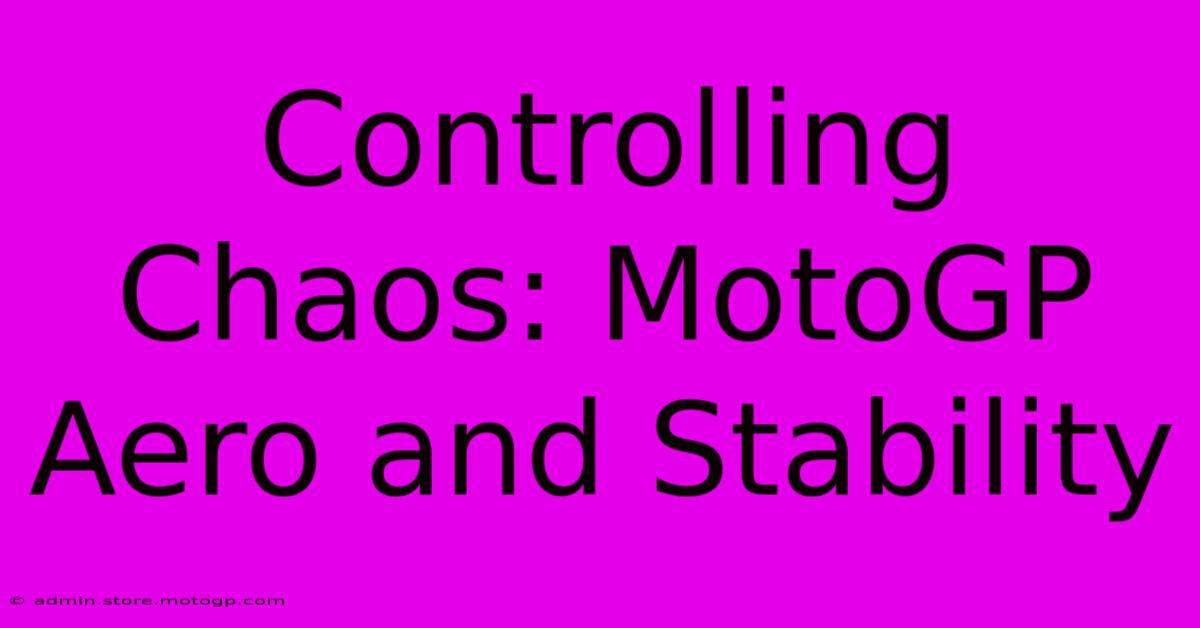Controlling Chaos: MotoGP Aero And Stability

Table of Contents
Controlling Chaos: MotoGP Aero and Stability
MotoGP. The pinnacle of motorcycle racing. Speeds exceeding 200mph, lean angles defying gravity, and a constant battle for milliseconds. But behind the breathtaking spectacle lies a complex interplay of forces, with aerodynamics and stability playing a crucial role in rider performance and safety. This article delves into the fascinating world of MotoGP aero and stability, exploring how teams meticulously manage these elements to gain a competitive edge.
The Aerodynamic Arms Race
MotoGP bikes aren't just fast; they're aerodynamically sophisticated. The relentless pursuit of speed has led to the development of incredibly complex aerodynamic packages, featuring:
- Wings: These aren't just for show. Sophisticated wing designs generate downforce, improving stability at high speeds and allowing riders to brake later and harder into corners. The placement and angle of these wings are meticulously adjusted based on track characteristics and weather conditions.
- Fairings: The sculpted bodywork of a MotoGP machine is far from random. Every curve and angle is designed to minimize drag and manage airflow, optimizing both top speed and stability.
- Air intakes and ducts: Carefully positioned air intakes feed the engine, while cleverly designed ducts channel air to cool vital components. These features must balance cooling efficiency with aerodynamic performance.
The Balancing Act: Downforce vs. Drag
The challenge lies in finding the perfect balance between downforce and drag. While downforce improves stability and cornering speed, it also increases drag, slowing the bike down on straights. Teams spend countless hours in wind tunnels and computational fluid dynamics (CFD) simulations to optimize this delicate equilibrium. This is a crucial element of MotoGP bike setup. Every adjustment influences this balance.
Maintaining Stability: Beyond Aerodynamics
Aerodynamics is just one piece of the puzzle. Achieving stability in MotoGP involves a holistic approach, incorporating various elements:
- Chassis Setup: The geometry and stiffness of the chassis directly influence the bike's handling and stability. Fine-tuning suspension settings, ride height, and rake are crucial for providing the rider with confidence and control.
- Tire Technology: Tire grip is paramount. The development of advanced tire compounds and constructions provides exceptional levels of traction, crucial for maintaining stability under extreme lean angles and braking forces. Tire pressure is also another crucial variable that needs to be carefully managed.
- Rider Skill: Even the most sophisticated aerodynamic package and chassis setup are useless without a skilled rider. Exceptional rider talent and intuition are essential for managing the bike's behavior and maintaining stability in challenging conditions.
The Impact of Track Conditions
Track conditions significantly impact both aerodynamics and stability. Changes in temperature, humidity, and track surface affect tire grip, and wind can dramatically alter aerodynamic forces. Teams must carefully adapt their bike setups and riding strategies to account for these variables. Understanding how weather affects performance is vital for a competitive advantage.
The Future of MotoGP Aero
The quest for performance is ongoing. Expect to see even more sophisticated aerodynamic solutions in the future, potentially utilizing active aerodynamics, where wing angles and other elements adjust automatically based on speed and track conditions. This will further blur the line between man and machine, pushing the limits of what's possible in motorcycle racing.
Conclusion:
Controlling chaos in MotoGP is a constant battle against physics. The intricate interplay between aerodynamics, chassis setup, tire technology, and rider skill determines success. As technology advances, the pursuit of greater stability and speed will continue to drive innovation and push the boundaries of this thrilling sport. The quest for perfection in MotoGP technology never ends.

Thank you for visiting our website wich cover about Controlling Chaos: MotoGP Aero And Stability. We hope the information provided has been useful to you. Feel free to contact us if you have any questions or need further assistance. See you next time and dont miss to bookmark.
Featured Posts
-
Moto Gp Helmet The Ultimate Riders Guide
Feb 20, 2025
-
Moto Gp The Thrill Of Speed Up Close And Personal
Feb 20, 2025
-
Moto Gp Crash Today The Aftermath Unfolds
Feb 20, 2025
-
Tnt Sports Moto Gp Ignite Your Passion For Racing
Feb 20, 2025
-
F1 Austin Where To Eat Stay And Play
Feb 20, 2025
